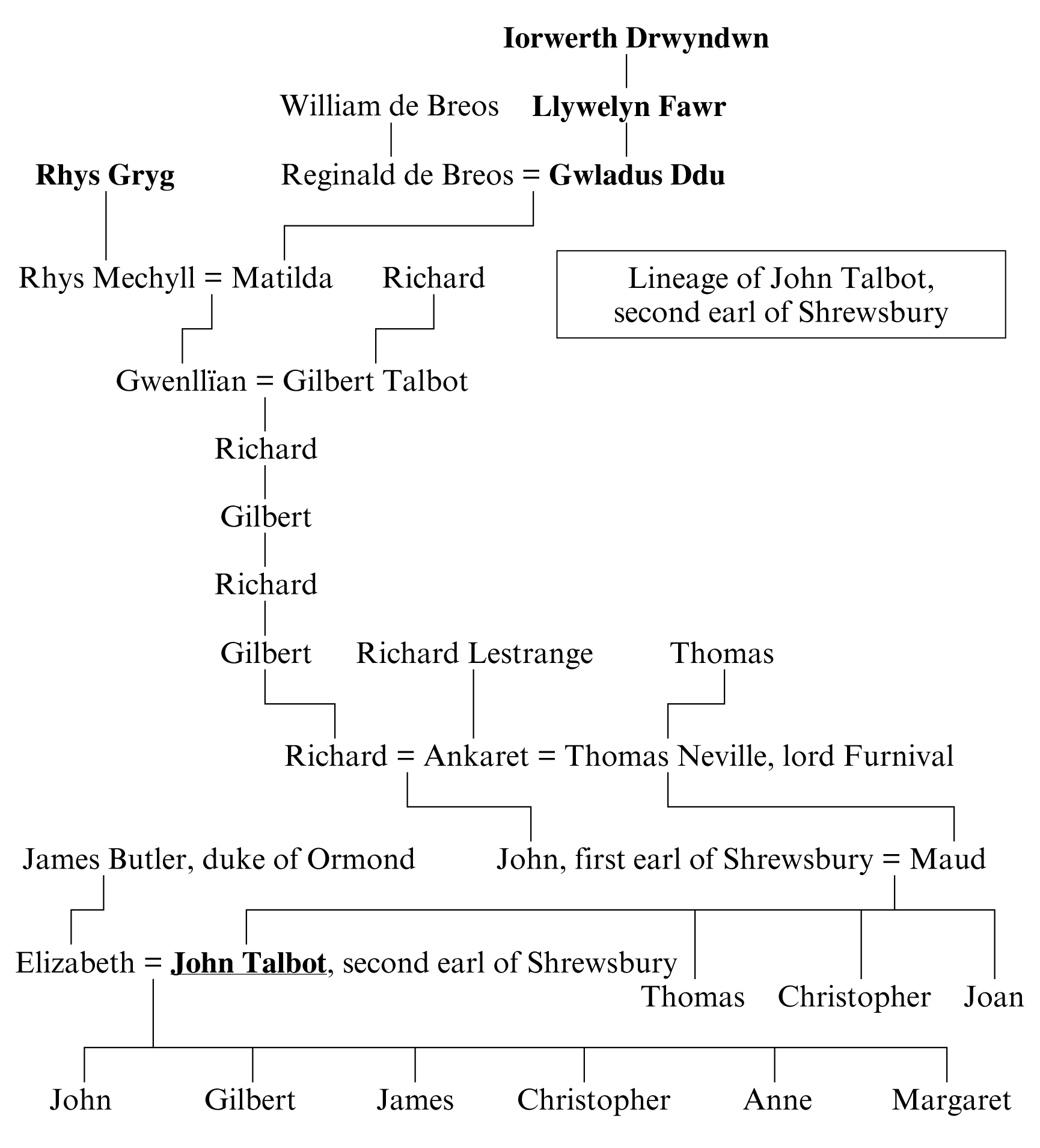Poem 78 was composed for John Talbot, second earl of Shrewsbury, the only extant poem for him.
Lineage
The genealogical table below is based on WG1 ‘Gruffudd ap Cynan’ 4, ‘Rhys ap Tewdwr’ 8; Cokayne 1887–98: 608–20; DNB Online s.n. John Talbot (first earl of Shrewsbury), John Talbot (second earl of Shrewsbury), William de Briouze. Those named in Guto’s poem are shown in bold print and his patron’s name is underlined.

Lineage of John Talbot, second earl of Shrewsbury
Bartrum’s genealogies note that Matilda was the daughter of one Reginald de Breos. It is unclear whether he was the Reginald de Breos whom Gwladus Ddu daughter of Llywelyn Fawr married as her first husband, nor whether Matilda was their daughter, yet this seems likely. Talbot had half-brothers and half-sisters from his father’s second marriage with Margaret Beauchamp, namely John, Humphrey, Lewis, Eleanor and Elizabeth.
His career
The information below was gleaned from DNB Online s.n. John Talbot (second earl of Shrewsbury). Guto’s patron was a son to the famous John Talbot, first earl of Shrewsbury (c.1387–1453), who made his name as a ferocious fighter in the closing stages of the Hundred Years War (on him, see ibid. s.n. John Talbot first earl of Shrewsbury; Pollard 1983). The father’s military career far surpassed that of his son, yet the second earl of Shrewsbury played a prominent part in British politics during the opening exchanges of the Wars of the Roses. He was knighted in 1426 and married Elizabeth daughter of James Butler, fourth duke of Ormond, in 1445. He was appointed the Crown’s chancellor in Ireland from 1445 to 1448 and from c.1450. Like both his father and his grandfather before him, Talbot was a Lancastrian and was active in Henry VI’s court in his opposition to the Yorkists from 1453. He was treasurer of England from 1456 to 1458 and a councillor for the prince of Wales in 1457. In the same year he was made a member of the Order of the Garter and was appointed chief justice of Cheshire in 1459. He died fighting for his king against the Yorkists at the battle of Northampton on 10 July 1460, and was buried in Worksop priory in Nottinghamshire.
Talbot’s relationship with his father was strained. From 1434 John Talbot, first earl of Shrewsbury, sought to arrange the passage of his estates so that it favoured both his second wife, Margaret daughter of Richard Beauchamp, duke of Warwick, and their children. John Talbot, his eldest son from his first marriage, stood to lose much of his inheritance. Nonetheless, when the first earl died in 1453, Talbot succeeded in taking control of his full inheritance. Guto’s poem deserves to be viewed in light of this controversy, for it is likely that it was composed between c.1437 and 1445, when John Talbot senior was actively dividing his lands between his sons. Guto gives Talbot senior six lines of praise and advises his son thus: Dysg wrthaw ‘learn from him’ (78.9–14). It would be interesting to know how the poet’s advice was received.
Bibliography
Cokayne, G.E. (1887–98), The Complete Peerage, vol. XII (London)
Pollard, A.J. (1983), John Talbot and the War in France, 1427–1453 (London)





